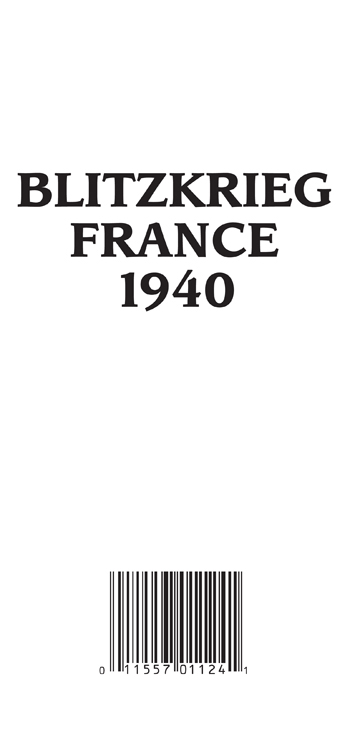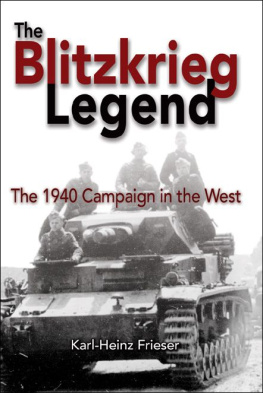Michael Olive - Blitzkrieg France 1940
Here you can read online Michael Olive - Blitzkrieg France 1940 full text of the book (entire story) in english for free. Download pdf and epub, get meaning, cover and reviews about this ebook. year: 2013, publisher: Stackpole Books, genre: History. Description of the work, (preface) as well as reviews are available. Best literature library LitArk.com created for fans of good reading and offers a wide selection of genres:
Romance novel
Science fiction
Adventure
Detective
Science
History
Home and family
Prose
Art
Politics
Computer
Non-fiction
Religion
Business
Children
Humor
Choose a favorite category and find really read worthwhile books. Enjoy immersion in the world of imagination, feel the emotions of the characters or learn something new for yourself, make an fascinating discovery.
- Book:Blitzkrieg France 1940
- Author:
- Publisher:Stackpole Books
- Genre:
- Year:2013
- Rating:5 / 5
- Favourites:Add to favourites
- Your mark:
- 100
- 1
- 2
- 3
- 4
- 5
Blitzkrieg France 1940: summary, description and annotation
We offer to read an annotation, description, summary or preface (depends on what the author of the book "Blitzkrieg France 1940" wrote himself). If you haven't found the necessary information about the book — write in the comments, we will try to find it.
- Hundreds of photos, many of them rare and never published before
- Photos of men, tanks, weapons, uniforms, terrain, and much more
- Excellent complement to the narratives of the Stackpole Military History Series
- Ideal reference for World War II history fans, scholars, modelers, and reenactors
Blitzkrieg France 1940 — read online for free the complete book (whole text) full work
Below is the text of the book, divided by pages. System saving the place of the last page read, allows you to conveniently read the book "Blitzkrieg France 1940" online for free, without having to search again every time where you left off. Put a bookmark, and you can go to the page where you finished reading at any time.
Font size:
Interval:
Bookmark:


Copyright 2013 by Stackpole Books
Published in 2013
by STACKPOLE BOOKS
5067 Ritter Road
Mechanicsburg, PA 17055
www.stackpolebooks.com
All rights reserved, including the right to reproduce this book or portions thereof in any form or by any means, electronic or mechanical, including photocopying, recording, or by any information storage and retrieval system, without permission in writing from the publisher. All inquiries should be addressed to Stackpole Books.
Cover design by Caroline M. Stover
Printed in the United States of America
10 9 8 7 6 5 4 3 2 1
Library of Congress Cataloging-in-Publication Data
Olive, Michael.
Blitzkrieg France 1940 / Michael Olive and Robert Edwards ; with a foreword by Chris Evans.
p. cm. (Stackpole military photo series)
Includes bibliographical references.
ISBN 978-0-8117-1124-1
eISBN 978-0-8117-4854-4
1. World War, 19391945CampaignsFrance. 2. Lightning war. I. Edwards, Robert. II. Title.
D755.2.O55 2012
940.54'214dc23 2012040023
CONTENTS
FOREWORD
I n the course of six weeks in the summer of 1940 beginning on May 10, the armies of France, Belgium, and Holland as well as the British Expeditionary Forcesent to the continent to support their allieswere routed by the German Wehrmacht in a stunning display of the new, modern form of warfare known as blitzkrieg. That France would fall in less than two months of fighting was shocking, certainly when compared to the stalemate battle of attrition of the First World War, when France successfully held the Germans at bay for four bloody years. How, it is fair to ask, could a once mighty militarysupported by alliesbe defeated so quickly and resoundingly?
On paper, the French military was formidable in 1940. With 5,000,000 men under arms; the massive and technically state-of-the-art defensive wallthe Maginot Linethat stretched the length of Frances border with Germany, in addition to elements of the line that extended all the way to the English Channel to the north and as far south as the Alps; and tanks like the thirty-ton Char B1, equipped with both a 75mm and 47mm gun and armor up to two and a quarter inches thick, France appeared capable of grinding down the German blitzkrieg and avoiding the fate suffered by Poland in September 1939.
Facing the French across the Maginot Line, the German Wehrmacht did not at first glance appear likely to race across France. Unlike the French and British, very little of the German Army was motorized, instead relying primarily on horses and rail to move troops, heavy weapons, and supplies. However, the panzer forcesin conjunction with the Luftwaffewould combine to punch through the Allies lines again and again, fighting and maneuvering at a pace far more rapid than the French and British were able to cope with.
France would sign an armistice with Germany on June 22, 1940, a swift and humiliating defeat made all the more bitter by Adolf Hitlers insistence that the ceremony be held in the same rail car in which Germany had signed its surrender at the end of the First World War. How the German Wehrmacht was able to accomplish this remarkable feat of arms is the subject of many narratives, including several in the Stackpole Military History Series. What Blitzkrieg France 1940 sets out to do is illustrate those ferocious six weeks of fighting with hundreds of photographsmany taken by the soldiers themselvesdetailing the rapid German advance and the brave but ultimately doomed defense of the French and British forces arrayed against them, culminating in the epic withdrawal of the BEF and many French soldiers from the beaches of Dunkirk.
Once again, Second World War military history experts Michael Olive and Robert Edwards provide context and technical information for the vast array of photographs, including the eight-page color insert featuring uniforms and weapons. The battle and, ultimately, fall of France are lavishly illustrated, providing a substantial and vivid account of those six terrible weeks.
Chris Evans
Editor
Stackpole Books
INTRODUCTION
POLAND AND THE PHONY WAR
On the morning of September 1, 1939, German forces invaded Poland. On September 3, Britain and France declared war on Germany in accordance with their treaty obligations.
The supposedly powerful Polish Army was decisively defeated and the country overrun in a matter of weeks. The fall of Warsaw on September 28 effectively ended the campaign, although there were some minor engagements lasting into early October.
During this time, the Western Allies did virtually nothing to effectively come to the aid of the Poles.
There was a tentative advance by the French against the thinly held German border. The so-called Saarland offensive was launched on September 7 by nine French divisions. These forces penetrated a distance of five miles along a sixteen-mile front, occupying a handful of insignificant villages.
The troops then halted and there was no further advance although German opposition was almost nonexistent. When Polish resistance collapsed, the troops were pulled back, and by October 4, all forces had withdrawn to the French frontier. Not a single German soldier was diverted from the assault on Poland.
The rapid conquest of Poland shocked the Western Allies and revealed to the world the revolutionary blitzkrieg (lightning war) concept of independent, fast-moving armored formations penetrating far into the battlefield, in conjunction with devastating tactical air support, causing a fatal dislocation of opposing armies deep behind the front.
The period from September 3, 1939, to May 9, 1940, was known in the West as the Phony War as both the German and Allied armies sat behind their respective frontiers. The French and British continued constructing fortifications and planning for the counterstroke to the expected German offensive. The Germans started planning for the attack on Western Europe.
Hitlers territorial ambitions lay in the East, not the West, and the decision of the British and French governments to declare war was not expected, given their recent history of appeasement over German territorial gains. When Hitlers tentative peace feelers in early October 1939 were rejected, there was really no alternative than to launch an attack in the West.
FALL GELB AND SICHELSCHNITT
The first German war directive concerning the attack in the West was Directive Number 6 for the Conduct of the War, issued on October 9, 1939. This directive called for the attack to be carried out in the autumn as soon as all plans were finalized and military units brought up to readiness.
The German General Staff was quite pessimistic about the attack on the West; the memories of the carnage of the Great War were still pervasive. This tentativeness was evident in the original plan they put forward, called Case Yellow (Fall Gelb). Case Yellow was not, as has often been stated, a rehashing of the Schlieffen Plan of 1914. That plan called for a massive enveloping movement from northern Belgium, pivoting on the coast, passing south of Paris, and isolating and destroying the bulk of the French and British armies.
If Case Yellow was a variant of the Schlieffen Plan, it was a distinctly anemic one. Essentially, it consisted of an enveloping movement on Ghent in order to separate the British Expeditionary Force from the French forces, defeating both in detail. Air and sea bases were to be secured for later employment against England. This was fundamentally a frontal assault by both the
Font size:
Interval:
Bookmark:
Similar books «Blitzkrieg France 1940»
Look at similar books to Blitzkrieg France 1940. We have selected literature similar in name and meaning in the hope of providing readers with more options to find new, interesting, not yet read works.
Discussion, reviews of the book Blitzkrieg France 1940 and just readers' own opinions. Leave your comments, write what you think about the work, its meaning or the main characters. Specify what exactly you liked and what you didn't like, and why you think so.












